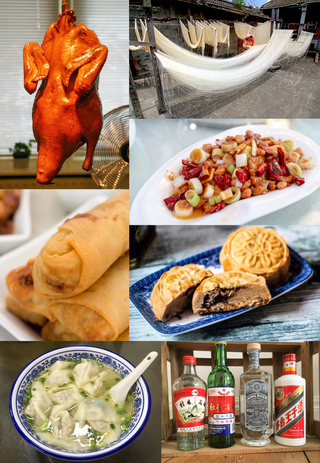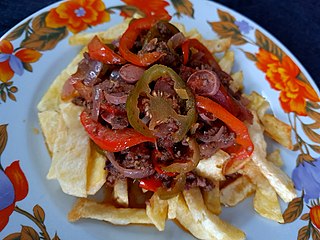Components of a cuisine
Food and drink
- Drink (beverages) of particular types – drinks are liquids specifically prepared for human consumption. In addition to basic needs, beverages form part of the culture of human society. Although all beverages, including juice, soft drinks, and carbonated drinks, have some form of water in them, water itself is often not classified as a beverage, and the word beverage has been recurrently defined as not referring to water. See List of beverages.
- Food of particular types, including the way it is presented – food is any substance [1] consumed to provide nutritional support for the body. It is usually of plant or animal origin, and contains essential nutrients, such as fats, proteins, vitamins, or minerals. The substance is ingested by an organism and assimilated by the organism's cells to provide energy, maintain life, or stimulate growth. See List of foods, Lists of prepared foods.
- Food presentation – art of modifying, processing, arranging, or decorating food to enhance its aesthetic appeal. The visual presentation of foods is often considered by chefs at many different stages of food preparation, from the manner of tying or sewing meats, to the type of cut used in chopping and slicing meats or vegetables, to the style of mold used in a poured dish. The food itself may be decorated as in elaborately iced cakes, topped with ornamental sometimes sculptural consumables, drizzled with sauces, sprinkled with seeds, powders, or other toppings, or it may be accompanied by edible or inedible garnishes.
- Food preparation styles – see Food preparation techniques
Meals
Meals (outline) – cuisine is generally served in the form of a meal. A meal is an eating occasion that takes place at a certain time and includes specific, prepared food, or the food eaten on that occasion. [2] [3] The names used for specific meals in English vary greatly, depending on the speaker's culture, the time of day, or the size of the meal. Meals are composed of one or more courses, [4] which in turn are composed of one or more dishes.
Meal structure in cuisines
Meal structure varies by culture. Here are some examples:
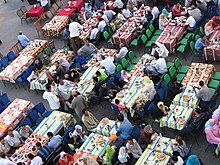
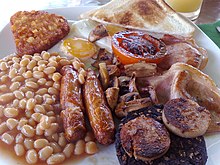
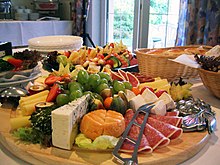
- Meal structure in Arab cuisine – includes breakfast, lunch, and dinner (including dessert). However, during Ramadan (9th month), fasting is paramount, and lasts from dawn to sunset. Each day during Ramadan, before dawn, many Muslims observe a pre-fast meal called the suhoor. After stopping a short time before dawn, Muslims begin the first prayer of the day, Fajr. [5] [6] At sunset, families hasten for the fast-breaking meal known as iftar.
- Meal structure in Bolivian cuisine – lunch (almuerzo) is the most important meal of the Bolivian day. Bolivians observe an afternoon tea time (té) similar to those in England. Dinner (la cena) is a lighter, much more informal affair than lunch.
- Meal structure in Danish cuisine – usually consists of a cold breakfast with coffee or tea, a cold lunch at work and a hot dinner at home with the family. Some also have a snack in the middle of the afternoon or in the late evening.
- Meal structure in Dutch cuisine – the Dutch eat at breakfast and lunch (which differ little from each other), tea time, and dinner (including dessert)
- Meal structure in English cuisine – Breakfast is traditional throughout England. Lower-middle-class and working-class people, especially from the North of England, the English Midlands, and Scotland, traditionally call their midday meal dinner and their evening meal (served around 6 pm) tea, whereas the upper social classes call the midday meal lunch (or luncheon), and the evening meal (served after 7 pm) dinner (if formal) or supper (often eaten later in the evening), [7] with afternoon tea as a light meal typically eaten between 4 pm and 6 pm.
- Meal structure in French cuisine – breakfast (le petit déjeuner), lunch (le déjeuner), dinner (le dîner) and dessert. Beverages that precede a meal are called apéritifs (literally: that opens the appetite), and can be served with amuse-bouches (literally: mouth amuser). Those that end it are called digestifs.
- Meal structure in German cuisine – traditionally, the day starts with breakfast (frühstück), lunch (mittagessen) is the main meal, followed by a smaller dinner (abendessen or abendbrot) with dessert.
- Meal structure in Iranian cuisine – breakfast is called sobhāneh. Lunch and dinner (naahaar va shaam) are not distinguished in Persian. You can usually find tea brewing throughout the day in most Iranian homes.
- Meal structure in Italian cuisine – breakfast (colazione), lunch (pranzo), mid-afternoon snack (merenda), and dinner (cena)
- Meal structure in Moroccan cuisine
